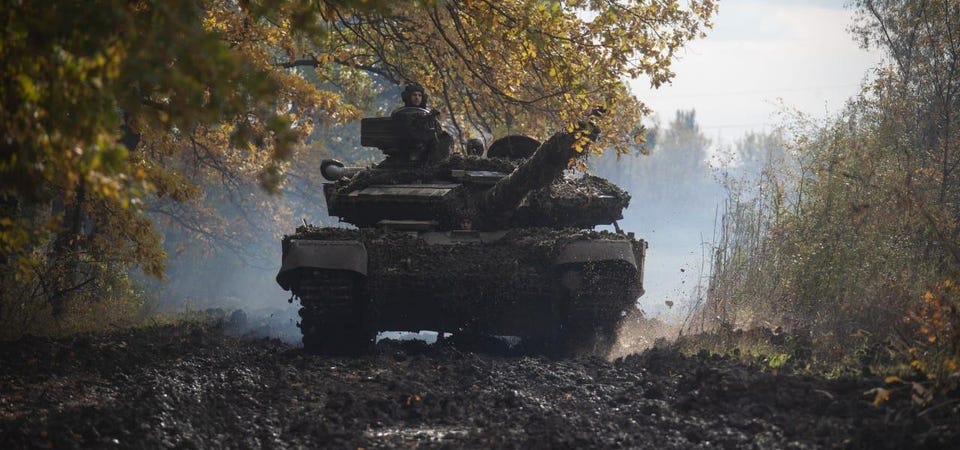There are two winters in Ukraine. The first, in the final couple months of the year, are cold—but not cold enough for a deep freeze. That means mud.
Deep, sticky, frigid mud. “Wet cold,” is how the U. S.
Army described it in an official winter field manual. The second winter, in the first couple months of the new year, is cold enough to freeze the mud. The U.
S. Army labeled this as “dry cold. ” While chillier, it’s much less hostile to troops and equipment.
In late October, the wet cold is just beginning. It’s going to get worse. Analysts for months have been predicting a pause in Russia’s wider war on Ukraine as the mud grows deeper and colder.
The Kremlin for one is counting on that pause to make good its devastating losses and regain some offensive combat power. Ukraine by contrast has momentum right now —and doesn’t want to lose it. Can Kyiv’s forces fight through the wet-cold and the dry-cold and maintain their hard-won battlefield advantage through the spring? It’s unclear.
What is clear is the dire meteorology that’s about to wage war on the Ukrainians and Russians while they’re waging war on each other . The United Nations’ refugee agency in 2019 profiled four Ukrainian civilians in eastern Ukraine’s Donbas region—where Ukrainian troops for five years had been battling Russian and separatist troops—in order to illustrate the sheer unpleasantness of the Ukrainian winter. “The temperature can get as low as -10 Celsius [14 degrees Fahrenheit],” a 71-year-old woman named Stefania told the U.
N. “Shelling makes things difficult at this time of year. When it starts, the first thing you do is run to the cellar, but it is very cold there.
When my house was shelled in 2015, I brought all the warm clothes and blankets I had. Even then, it was cold. ” It arguably is even worse for troops out in the field, especially in the wet-cold months.
“The ground becomes slushy and muddy and clothing and equipment becomes perpetually wet and damp,” the U. S. Army explained.
“Because water conducts heat 25 times faster than air, core body temperatures drop if troops are wet and the wind is blowing. ” “Troops become casualties due to weather if not properly equipped, trained and led. Wet-cold environments combined with wind is dangerous because of the wind’s effect on the body’s perceived temperature.
Wet-cold leads to hypothermia, frostbite and trench foot. ” While soldiers struggle to stay dry and warm, commanders struggle to keep battalions moving. “Under wet-cold conditions, the ground alternates between freezing and thawing because the temperatures fluctuate above and below the freezing point,” the U.
S. Army explained. “This makes planning problematic.
For example, areas that are trafficable when frozen could become severely restricted if the ground thaws. ” Engineers become indispensable. They grade roads and forest tracks, tow mired vehicles and bridge rain-swollen rivers.
But they too struggle with the elements. “Heavy equipment and combat engineer operators exposed to the elements rapidly become fatigued and require regular relief after short periods,” according to the U. S.
Army. It’s apparent the Russian army, having lost 100,000 men killed and wounded since February, has no intention of mounting offensive operations in Ukraine this winter. Battered battalions in Donbas are digging in, sowing rows of concrete anti-tank defenses and hoping to receive as reinforcements some of the 300,000 men the Kremlin drafted this fall.
The Ukrainians might try to fight through the wet cold, however. After all, waiting until spring to continue attacking could give the Russians all the time they need to rebuild damaged formations—and restore battlefield parity. By the same token, if Ukrainian brigades mount an early-winter offensive, they might be able to hit mud-bound Russian forces while they’re at their weakest.
It’ll require careful planning, robust logistics, expert engineering support and incredible grit from the front-line troops. Mick Ryan, a retired Australian army general, said he’s bullish . “We may see more adaptations by the Ukrainians to use winter to their advantage.
”.
From: forbes
URL: https://www.forbes.com/sites/davidaxe/2022/10/29/the-russian-and-ukrainian-armies-brace-for-the-dreaded-wet-cold-winter/
